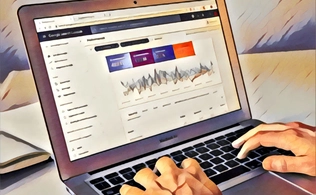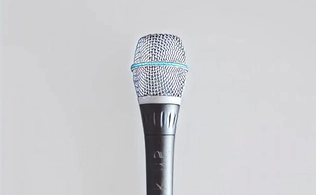Focus groups are a research method most often associated with marketing research, market research, and, increasingly, UX research.
Within the latter, through discussion very often serve to seek and achieve new ideas and find new digital solutions in a particular field or industry.
This research method is very eagerly used when designing branding and corporate identity. But the application of focus groups is, of course, much broader.
Focus Group Interviews have been used in the field of academic research — primarily sociology, psychology, and anthropology — for a very long time.
The method is not new. It was developed in the first half of the 20th century, precisely during World War II, and was created by prominent American sociologists Robert Merton and Paul Lazarsfeld.
The vast advantages of focus group interviews have caused the method to be repeatedly modified, developed, and adapted to the needs of various studies, including studies on the usability of digital products.
In this article, we will try to familiarize you with focus groups and answer the most critical questions.
What are focus groups? How long does an FGI take? What is an FGI – Focus Group Interview?
What are the characteristics of focus group interviews?
Focus groups nowadays are almost canonical research, and they definitely cannot be missing from the corpus of methods and research techniques of professional User Experience researchers.
Without further ado, we cordially invite you to read on!
Focus groups — what are they?
We should start answering the following questions — What are focus groups? What is an FGI (Focus Group Interview)? — by defining this research method.
The description of this method is quite simple.

The focus group belongs to the group of qualitative moderated research and consists of a guided, focused conversation among respondents on specific problems.
It is a study performed through discussion in which participants can express their opinions and emotions and outline attitudes.
A focus group's conversation on a particular topic usually involves five to ten participants.
The course of the conversation is controlled by a moderator, whose role is to ask questions to the group and direct the discussion to the desired topics, problems, and issues.
The size of the group and the number of study participants are not random. Larger groups of more than ten people raise many problems regarding organization, communication, and time.
A group that is too small does not provide good diversity and the desired dynamics of interaction among its members. They may not explore a particular topic in enough depth.
On the other hand, a group that is too large raises the problem of uneven engagement of participants, the issue of its moderation, and the fulfillment of objectives arising from the study scenario, which is prepared before its execution.
Too large a group can also limit the spontaneity of people who are uncomfortable in big gatherings. Furthermore, respondents in too numerous groups may negatively influence each other.
How long does a focus group interview take? Typically, the time required for a research session does not exceed two hours; at a minimum, it usually lasts an hour.
A focus group is used to learn about respondents' perceptions, not behavior.
The influence of the group can be very helpful — it can encourage insights into issues that would not have had a chance to be uncovered in Individual In-Depth Interviews (IDIs).
But it also has its flipside, which we will write more about later.
Focus group interviews are most commonly used to:
- Gain insight into how to define, describe, and experience usability problems
- Learn about the scope and depth of user experience
- Discover opinions, attitudes, preferences, biases, and experiences
- Learn about spontaneous and uncontrolled responses
- Obtain fresh and new perspectives, ideas, concepts, and solutions
- Get useful feedback.
Focus groups owe their reputation to their ability to obtain a large amount of information in a relatively quick, inexpensive, and uncomplicated manner.
The data obtained during the study with this method (the material may include not only the notes of the research assistant but also recorded auditory, audio-visual material, and transcriptions) are usually synthesized and used to formulate conclusions and new hypotheses.
Focus group interviews also provide helpful material for preparing design recommendations and determining the direction of digital product development.
At the same time, it is essential to remember the cardinal remark made by usability research guru Jakob Nielsen — what people say and do are two different things.
For more on this topic, you can read Nielsen's article "First Rule of Usability? Don't Listen to Users."
Hence, the results obtained through focus groups should be treated with some caution and confronted with the results of usability tests, in which user actions are the main focus of the study.
Their meaning and usefulness become more critical when they are treated as part of a larger piece of diverse research, leading to an understanding of users' relationship with the digital product in a multi-dimensional, multi-perspective, multi-problem manner.
You should also remember that focus group interviews are not used for usability testing. There are fundamental differences between these research methods.
Mainly, they differ in the following aspects:
- Types of obtained data during a study are different
- The subject of the research is different — in short, FGI focuses on what people think, while usability tests focus on behavior
- Verification of research material — the "truthfulness" of actions is easy to ascertain. You cannot unquestionably verify the "truthfulness" of declarations, opinions, and beliefs.
Of course, from the above points, you cannot draw the wrong conclusion regarding the complete uselessness of this research method in the design, optimization, and development of digital products.
Focus group interviews — advantages and disadvantages
Let's start with an important statement that focus groups are a research method you should use for specific purposes.
Focus groups have advantages and disadvantages, but that much is obvious. In UX, they are useful for creating a better digital product, launching new digital services, performing optimizations, and getting hints. They are a source of design and research inspiration.
Above all, they are used to gain insight into how product users think and react.
To a large extent, the material collected with them is a result of several things:
- Group dynamics (in terms of social, psychological, and emotional interactions)
- Relevance and adequacy of questions prepared by a UX researcher, which should be of interest to the respondents (prompting them to express an opinion, for example)
- Moderator's ability to moderate the discussion
- Time devoted to the study
- Criteria for selecting respondents
- Self-awareness, openness, and communicativeness of respondents
- Impact of the Groupthink syndrome
- Respondents' understanding of the study's objectives, its conduct, and the role they play is essential.
The disadvantages of focus groups include the following:
- Possibility of dominating the thoughts, reactions, and evaluations of the group by dominant individuals who like to draw attention to themselves
- High dependence of research results on the experience and skills of the focus group moderator
- Limited interaction with the product. The feedback does not always coincide with that which can be gleaned when there is actual interaction with the product when a longer, more natural interaction shapes the experience
- The need to filter respondents (perform screening tests) in terms of, for example, their placement on the introversion-extroversion spectrum
- Inability to predict the course of the study.
When conducting focus group interviews, you should pay special attention to the following:
- Range of topics — their number and complexity must be matched to the time that you will spend on the study (as a rule, it is better to focus on fewer topics but in a more in-depth manner)
- You should test questions before the study session
- The order of questions should be natural, logical, and reasonable
- Moderation of the research should follow the prepared scenario
- A moderator should not take any notes during the study — their assistant should be delegated to this task
- A moderator should only initiate discussions, not take an active part in them
- Questions and answers should be diversified with other activities.
As we mentioned, qualitative research, including the quality of results obtained through focus groups, depends on many factors.
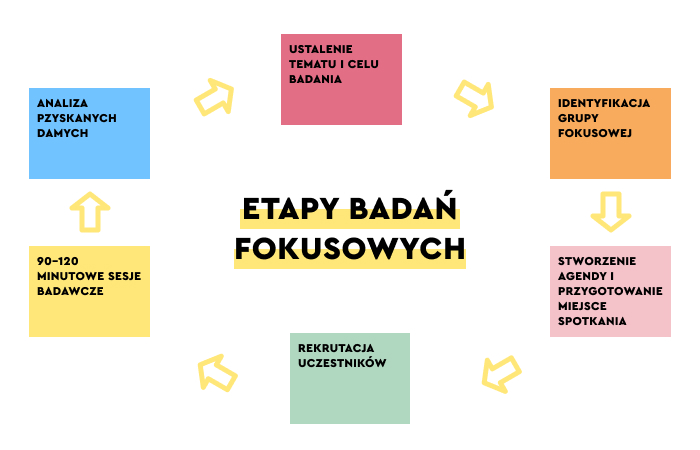
A moderator, whose task is to direct the discussion, ensure the comfort of all participants, and counteract the effect of groupthink, plays a key role.
They should be characterized by the following:
- Above-average communication skills
- Proper timing
- Adequate responsiveness — they should be passive, tactful, or active, taking the initiative depending on the changing interactions between the research participants
- Commitment, enthusiasm, and genuine curiosity
- Ability to encourage the more withdrawn respondents to join the discussion
- Good memory
- Ability to listen
- Flexibility and quick adaptation to changing circumstances
- Ability to manage and organize
- Inquisitiveness
- Empathy — the ability to understand emotions and feedback (which can, for instance, indicate tiredness, fatigue, or the need for a break).
The dependence of the study's results on the skills, experience, and predispositions of a moderator is both an advantage of focus groups and a disadvantage.
An advantage because by hiring a researcher who guarantees high quality and reliability, you can gain a lot.
A disadvantage because the ability to moderate is uncommon and is sometimes costly.
Considering all of the above information, we inevitably come to the crucial questions.
What is the usefulness of this kind of UX research in the process of designing, developing, and creating web and mobile applications?
Why should you use focus groups to create digital products?
The usefulness of focus groups in UX research
You are ready to conduct a focus group interview with a Minimum Viable Product (MVP) or a clickable digital product prototype, a proper moderator, and a set of good, relevant questions.
You can gain insight into how users and focus group participants react to a digital product or its particular functionalities. You can achieve a better understanding of them.
Focus groups are also a source of new ideas — functional and regarding usability.
Remember that focus groups provide insight into verbal reactions and reactions manifested through body language and facial expressions.
It is essential in conducting a study using focus groups to formulate questions based on adopted hypotheses.
The assumptions you make about the product, functionality, usability, performance, interaction, and attractiveness must be reflected in the questions.
For instance, in terms of usability, you can formulate probing questions about what should be changed, improved, removed, or added.
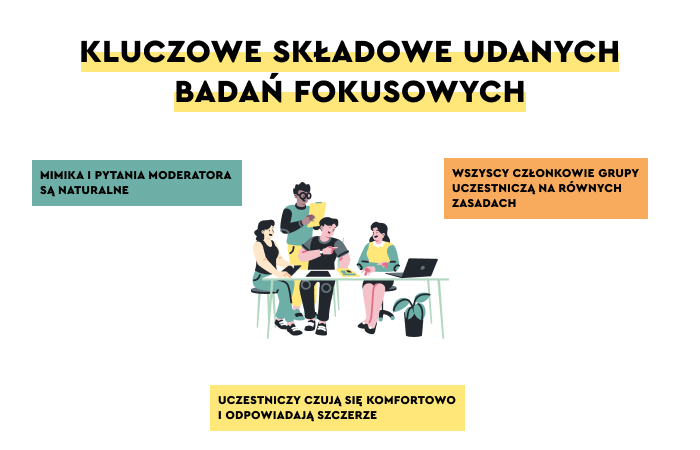
Regarding interactions, you could ask study participants about situations that confused, distracted them, or seemed meaningless to them.
In terms of information architecture, the comprehensibility of the verbal layer, you can ask respondents to point out content that seemed incomprehensible, ambiguous, or confusing and about the content that may be missing.
The usefulness of focus groups in the User Experience research process is primarily expressed in providing researchers with knowledge about:
- Opinions about a digital product
- Attitudes it generates
- Reactions it triggers
- Feelings that a user experiences when interacting with a digital product
- Beliefs and biases that may constitute barriers to using the product
- Preferences — research allows you to collect feedback regarding what users like and what they do not find attractive or enjoyable
- Needs — expressed in the identification of functionalities that are necessary, useful, and completely useless.
In User Experience research (as in all types of qualitative research), the outcome depends on the meticulousness with which researchers adhere to methodological norms.
We want to remind you that research methodology consists of developed recommendations regarding the correct way to conduct a study step by step.
Following the rules of the art of research guarantees the reliability of the results.
It is also worthwhile to follow best practices in research, including focus groups.
Compliance with the formal methodological standard is obviously necessary.
Although compliance with best practices is not mandatory, it certainly proves the reliability of the researcher and their concern for the quality of the results and the conduct of the study (for example, through high research ethics).
It supports obtaining useful results and provides a compelling basis for design and business decisions.
Best practices in UX research using focus groups
Let's start with a fundamental matter, namely, at least two people should conduct focus group interviews.
The research should be performed by a moderator and an assistant, a second researcher who focuses on taking notes and meticulously observing the study participants.
Moderating — if it is to be carried out effectively and serve the research purpose — is such a demanding, absorbing activity that it should not be further disturbed by the need to perform other actions.
The moderator's effectiveness depends mainly on the prepared UX research plan, the scenario, and the list of questions they will ask in the course of the study.
The UX research plan enables the study to be conducted in an orderly, goal-focused, exhaustive manner and provides a clearer, more controlled flow.
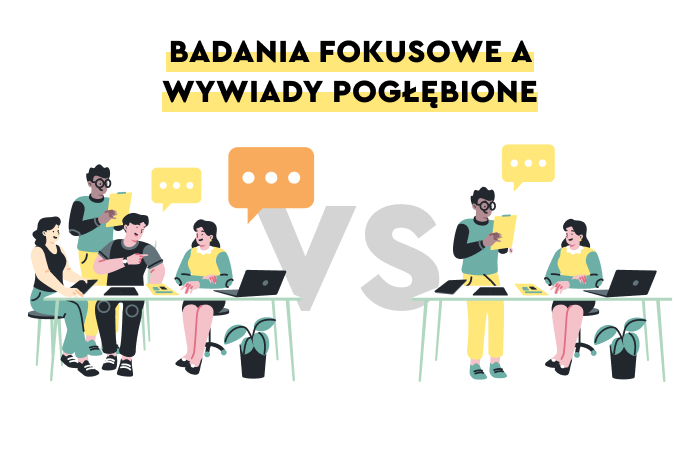
However, you should remember that the moderation of focus groups should be as natural, flexible, and open as possible. The research plan and the scenario are only a framework, which leaves room for maneuvering for the moderator.
Rigid adherence to an exact scenario negatively affects the session and is definitely not recommended.
Focus groups have their own peculiarities, which must be respected. High variability, dynamics, and unpredictability are — for an experienced moderator — an opportunity rather than an obstacle to achieving the research goal.
A moderator should maintain complete impartiality and should not share personal judgments, opinions, or beliefs with respondents. Their role is not to actively participate in the discussion but to activate it.
Also, their emotions, tone of voice, and body language should be as neutral as possible. They should not affect the course of the study and the participants' mood, feelings, and comfort.
You should also remember that focus groups are a research method that should be considered complementary within the UX research corpus.
It should be used in tandem with other methods, making it possible to formulate much more conclusive and convincing conclusions.
In other words, focus groups should not be treated as the only source of information or knowledge but as a tool to learn about a specific dimension of users' relationship with digital products.
Focus groups as a UX research method. Summary
- Focus groups consist of a directed, problem-focused conversation among respondents conducted in a small group by a moderator.
- In social research, focus groups are a qualitative method used to learn about respondents' perceptions, declarations, assessments, opinions, emotions, and reactions, not their behavior.
- Focus groups usually consist of five to ten participants.
- A moderator controls the course of the conversation during the focus group interview.
- The role of a moderator, a facilitator, a UX researcher is to ask questions to group members and direct the discussion to desired topics, problems, and issues.
- The small number of participants in the study is not a coincidence.
- A group that is too small does not provide good diversity and the desired dynamics of interaction among its members.
- A group that is too large raises the problem of uneven engagement of participants and the issue of its moderation. Achieving a smooth group discussion becomes difficult. Its course is chaotic.
- The data obtained during a focus group interview is usually combined with the results of other studies and is used to make project and business decisions and to pose new hypotheses.
- Focus groups are not meant for usability testing. They are used to gain insight into how product users think and react.
- In this research method, a moderator plays a key role, whose task is to direct the discussion, ensure the comfort of all participants, and counteract the effect of groupthink.
- It is essential in conducting a study using focus groups to formulate questions based on adopted hypotheses.
- The assumptions you make about the product, functionality, usability, performance, interaction, and attractiveness must be reflected in the questions.
- Moderating focus groups should be natural, flexible, and open.
- A research plan, a study scenario using a focus group, is just a framework that leaves a large room for maneuvering for a moderator.
- The smooth conduct of the study is primarily controlled by a moderator, who initiates the discussion and refers to the scenario as infrequently as possible to deepen the issue.
- A moderator should remain completely impartial during the study.
- They should not express personal judgments, opinions, and beliefs.
- The Moderator's emotional reactions, tone of voice, and body language should be as neutral as possible.
- It is about achieving the fluidity that a discussion should have.
- Focus groups should not be treated as the only source of information or knowledge about users of digital products.
- Regarding UX research, this method should be treated as a tool to learn only a specific dimension of users' relationship with digital products.



